
The Bottom Line
Introduction, Specifications, and Pricing
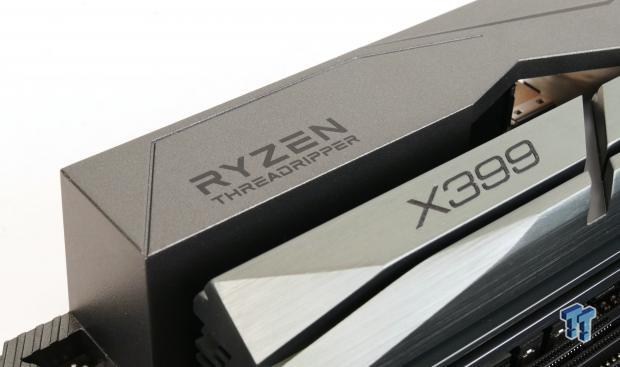
AMD's Threadripper CPUs dropped onto the market last week and with it a handful of motherboards built with the AMD X399 chipset. The chipset itself is similar to the X370 chipset, as in it acts as a south bridge, with the CPU providing a large amount of IO.
While the CPU SoC offers 60 lanes of PCI-E 3.0 (four other lanes connect to the X399 chipset) for up to seven devices, it also provides HD audio, eight USB 3.0 ports, and the SPI bus (BIOS communication). The X399 chipset offers eight SATA 6Gb/s ports, eight PCI-E 2.0 ports, two USB 3.1 ports, five USB 3.0 ports, and six USB 2.0 ports. There are also two PCI-E 3.0 ports in the X399 chipset that can be used for an extra four SATA ports or two SATA Express ports.
ASRock's X399 Taichi takes full advantage of the new X399 chipset and includes many of ASRock's unique features. The motherboard is just as loaded with features as any HEDT platform from the competition and offers the same level of modern connectivity. The X399 Taichi also focuses heavily on overclocking features, and that includes a high-quality VRM.
Let's begin our first AMD X399 motherboard review with the X399 Taichi.
Specifications

The X399 Taichi features dual Intel NICs, USB 3.1, USB 3.0, SATA6Gb/s, three Ultra M.2 slots, support for up to 4-way SLI/CrossFireX, U.2, and even multiple RGB LED headers.
Pricing
The ASRock X399 Taichi costs $339.99.
Packaging and X399 Taichi Overview
Packaging and Overview
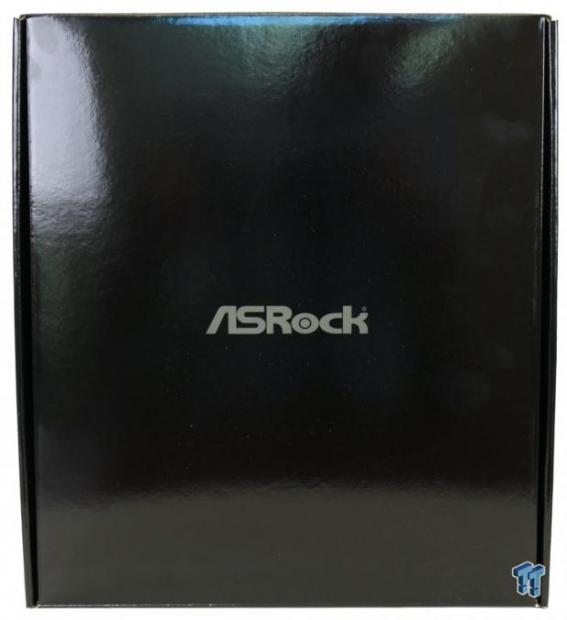
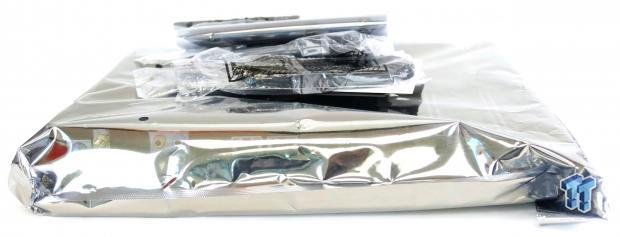
The final retail box has a gray and black aesthetic to it; this was just the box our early sample arrived in. Packaging is done well, and the accessories and motherboard are all well protected.
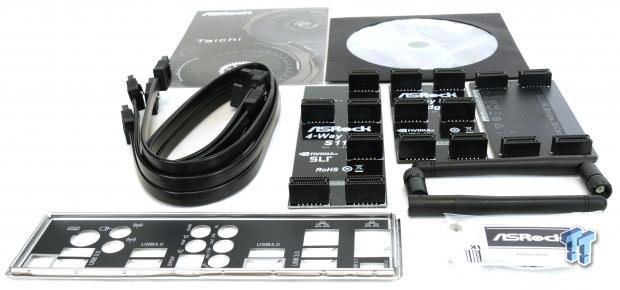
The accessory package includes four SATA6Gb/s cables, a 4-way SLI bridge, a 3-way SLI bridge, an SLI HB bridge, M.2 screws, WIFI antenna, IO shield, a Post Card, manuals, and driver DVD.
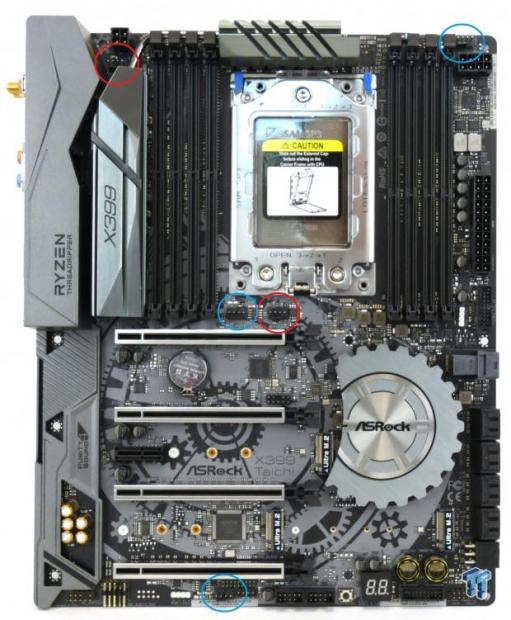
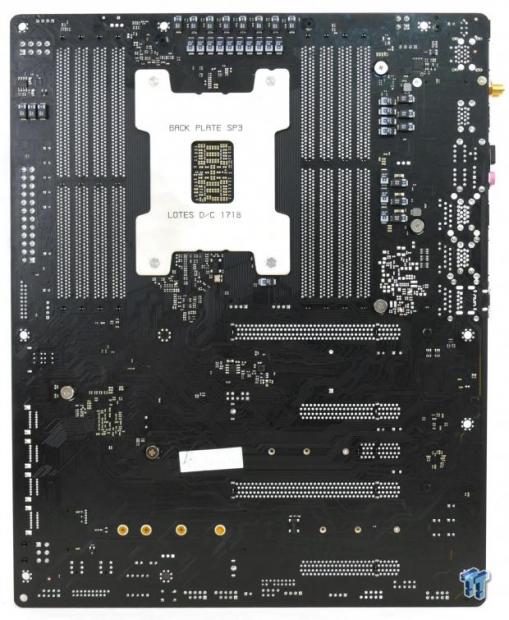
There are five fan headers on the motherboard, and all of them are hybrid DC/PWM mode headers. All of the fan headers provide auto sensing of PWM/DC mode fans except for the CPU fan header; I believe it is PWM only. All the headers provide 1A of current, except the two headers circled in red that offer 1.5A for pumps and other high current fan header devices. UEFI and OS based fan control is present, and you get a GUI as well as manual input fields in the UEFI.
The motherboard's "gear" aesthetics are prominent, but I was surprised that ASRock didn't move a lot of the circuitry to the back of the motherboard to make the PCB look cleaner. The back of the PCB features many of the POSCAP capacitors used to filter out ripple for the CPU and memory VRMs.

The rear IO panel features PS/2 Keyboard/Mouse, BIOS FlashBack button, eight USB 3.0 ports, USB 3.1 type-A, USB 3.1 type-C, two WIFI antenna, two Gbit LAN ports, and gold plated 7.1 channel audio outputs with S/PDIF optical.
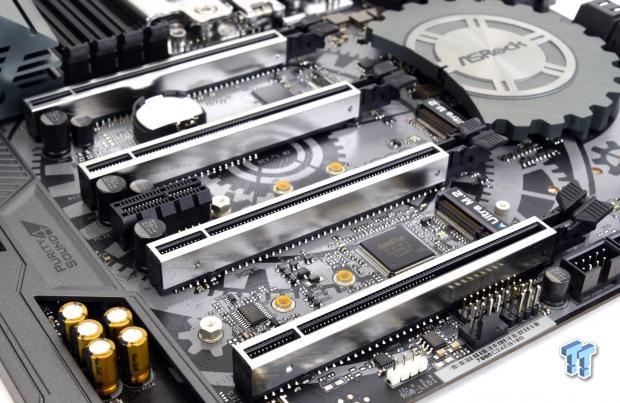
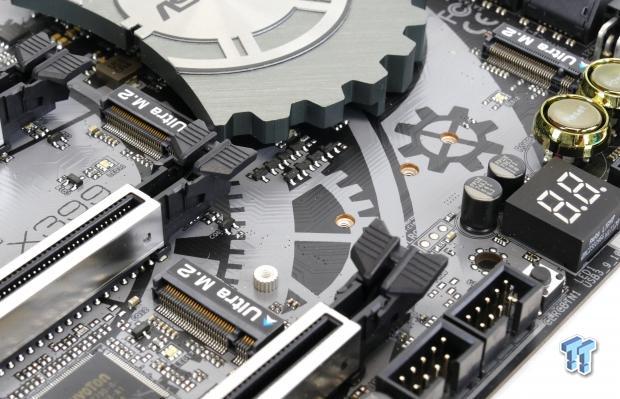
The PCI-E layout is quite simple as there are so many PCI-E lanes from the CPU that switching of bandwidth is almost nonexistent board-wide. The first and third metal reinforced x16 slots offers x16 PCI-E 3.0 full time, while the other two offers x8 PCI-E 3.0 all the time. The center PCI-E x1 slot is PCI-E 2.0 from the chipset. The motherboard also features three 32Gb/s M.2 slots that connect directly to the CPU. The topmost M.2 slot shares x4 PCI-E 3.0 with the U.2 connector.
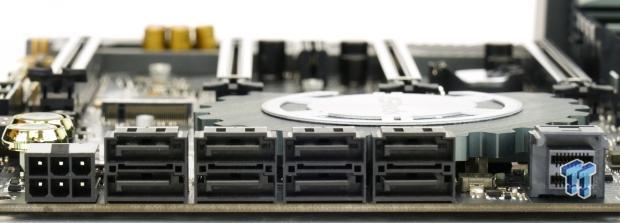
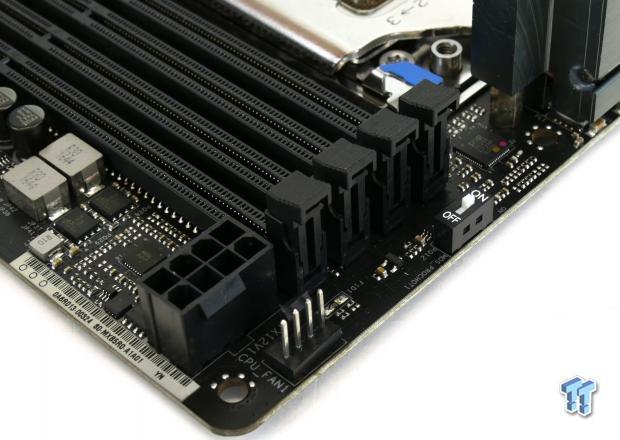
Eight SATA 6Gb/s ports connect to the chipset, the U.2 connects to the CPU and shares x4 PCI-E 3.0 with M2_1, and a 6-pin PCI-E port plug is used to provide more power for the PCI-E slots. A MOS_PROCHOT switch can enable or disable the PROCHOT signal for extreme overclocking scenarios. The motherboard has an 8-pin power plug for the CPU as well as a 4-pin plug used for extra CPU VRM power.
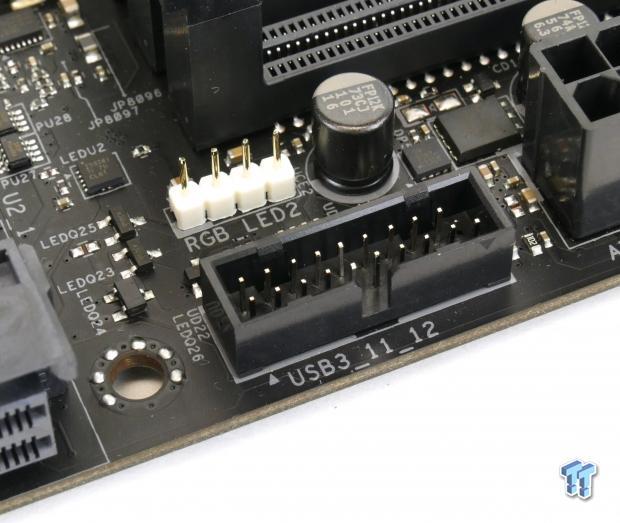
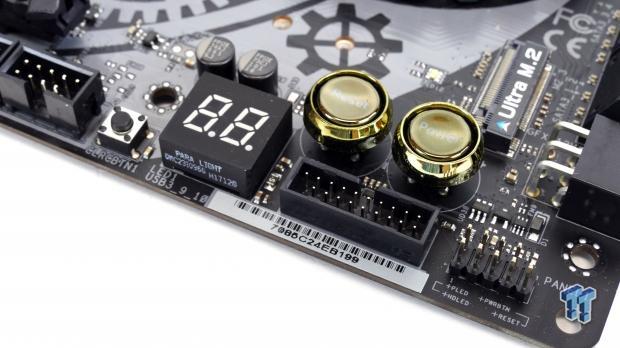
One USB 3.0 internal header sits right below the 24-pin power connector, and behind it is an RGB LED header. The motherboard's front panel connectors are in the lower-right corner of the motherboard. A USB 3.0 internal header is located at the bottom of the motherboard near the POST Code display, Power button, Reset Button, and Clear CMOS button.
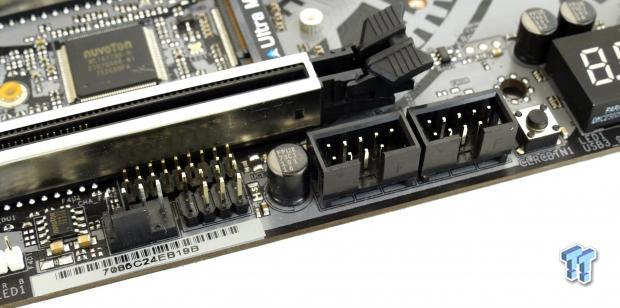
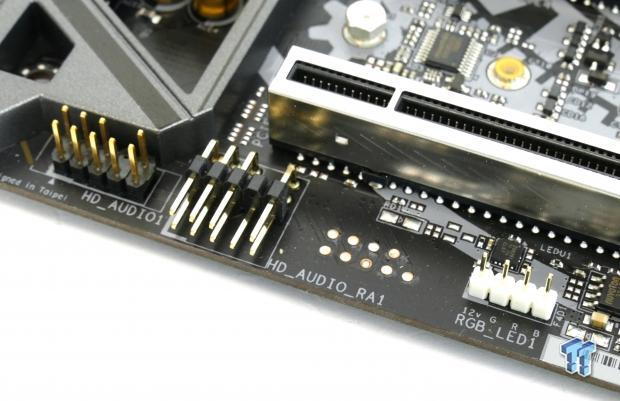
The motherboard also features two USB 2.0 headers at the bottom of the motherboard. A second RGB LED header sits at the bottom of the motherboard near two HD audio headers. There are two HD audio headers, making it easy to plug in if you have a GPU in the bottom most slot or have a short case.
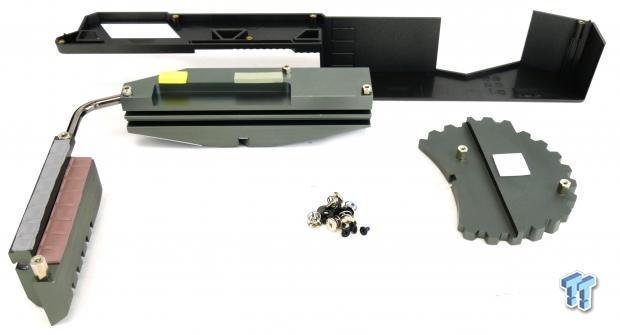
The VRM heat sink cools the MOSFETs and inductors and connects to a larger heat sink through a heat pipe. The secondary heat sink cools the SoC VRM while also handling more heat from the CPU core VRM.
ASRock X399 Taichi Circuit Analysis
Circuit Analysis
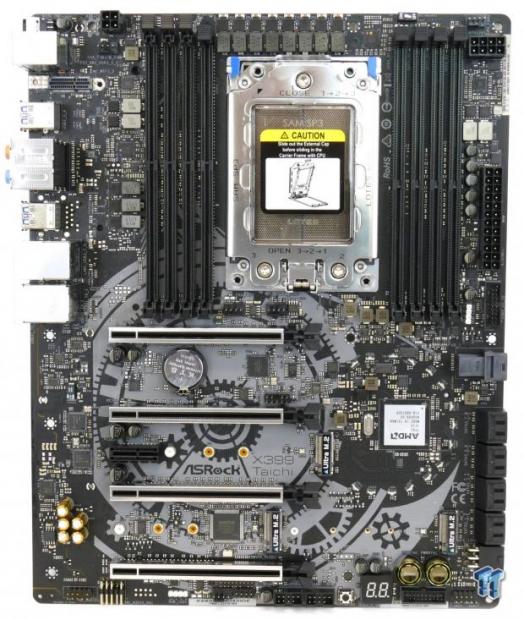
The X399 Taichi shows us what it's got under the hood when we remove the heat sinks and shields.
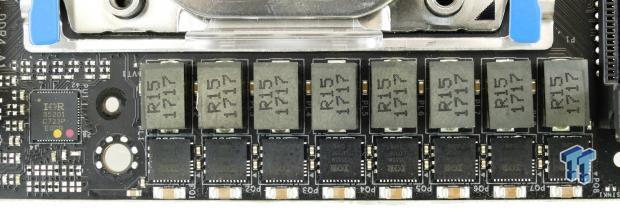
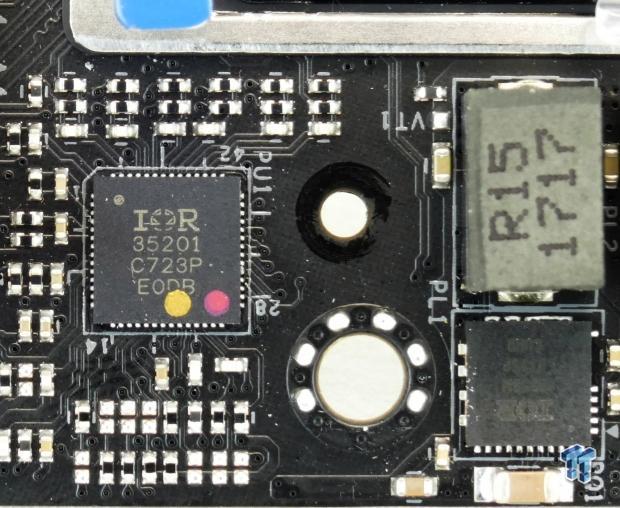
The VRM for the core VRM is a true 8-phase VRM. It's controlled by International Rectifier's IR35201 in an 8+0 phase PWM configuration. Each phase uses a 60A IR3555 fully integrated PowIRstage power stage, which contains the high-side MOSFET, low-side MOSFET, and driver. The inductors are rated for 60A, and the main VRM uses multiple POSCAP tantalum capacitors on the back side of the PCB for its LC filter.
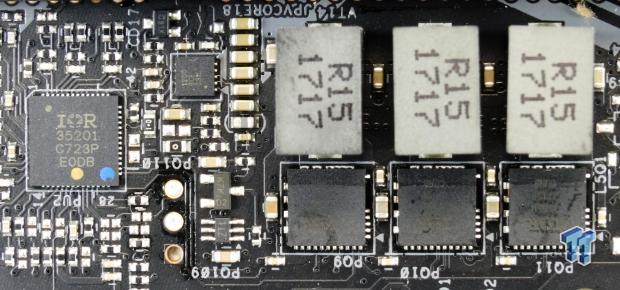
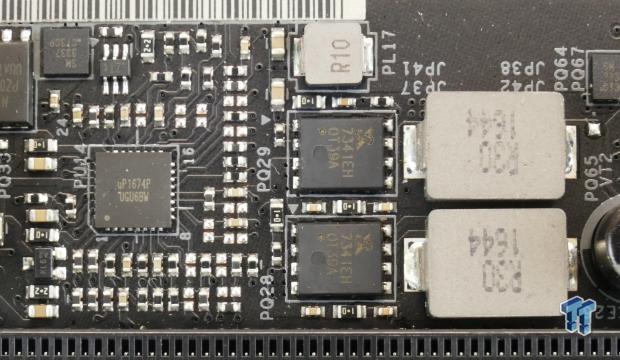
The SoC VRM consists of three phases made up of the same components as the CPU core VRM and is controlled by an IR35201. Each memory VRM uses a UPI Semiconductor uP1647P PWM to control and drive two SinoPower SM7341EHKP dual N-Channel MOSFETs.
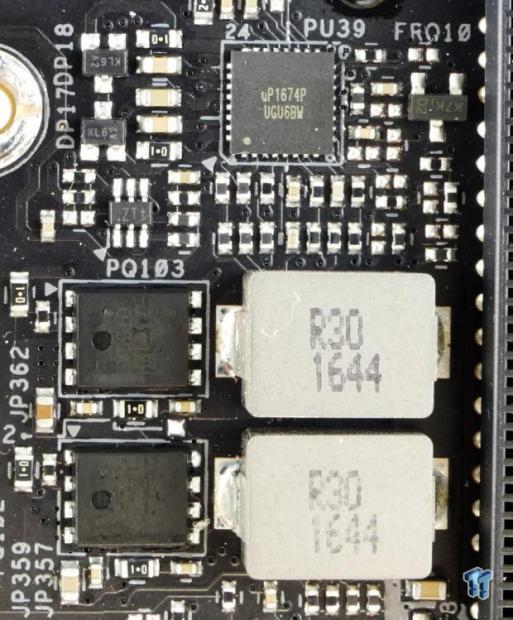

Each set of 4-DIMMs is powered by the two phase SinoPower/uPI semiconductor VRMs. There are also three other power circuits that use linear regulators (rather than switching). The Richtek RT8065 are used as 3A linear regulators, for minor CPU voltage rails.
ASRock X399 Taichi Circuit Analysis Continued
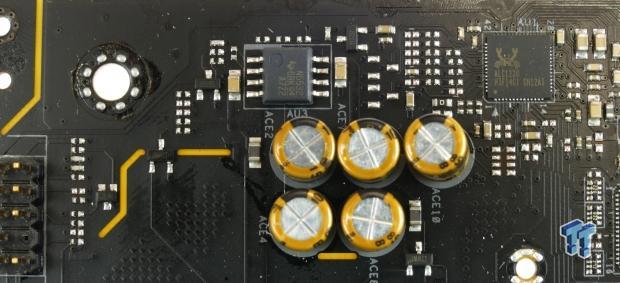
ASRock is using a Realtek ALC1220 rated for 120dB and contains an integrated headphone amplifier. A second Texas Instruments NE5532 amplifier is used to amplify the integrated front panel header's headphone output, and gold electrolytic audio capacitors and a physical PCB divide help improve overall audio quality.
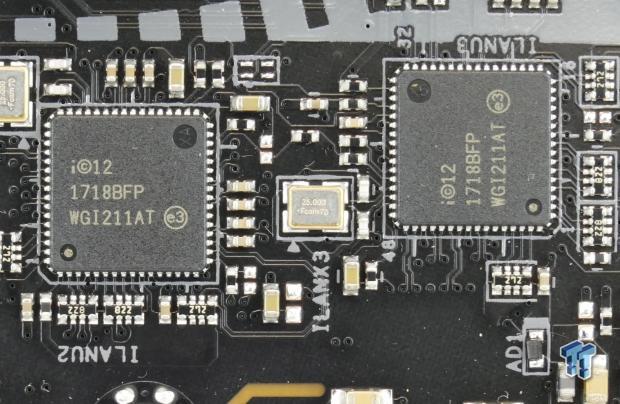
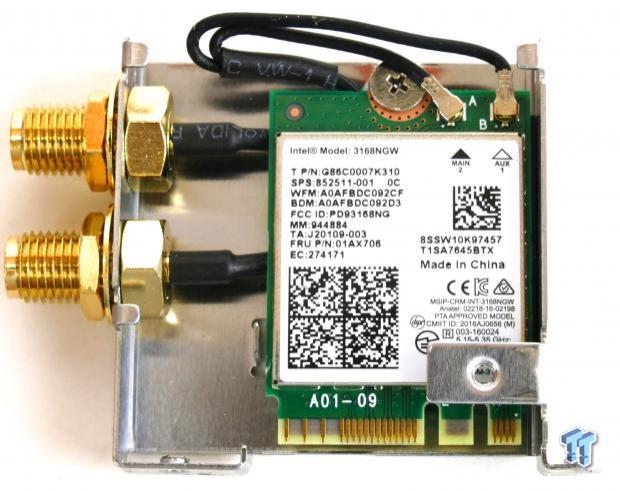
Two Intel i211AT Gbit NICs provide the two LAN ports on the rear IO. An Intel Wireless AC 3168NGW provides 433Mbps WIFI.
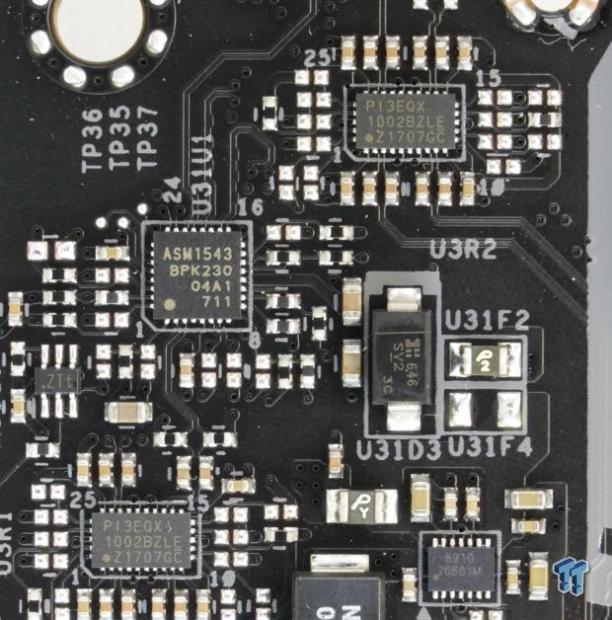
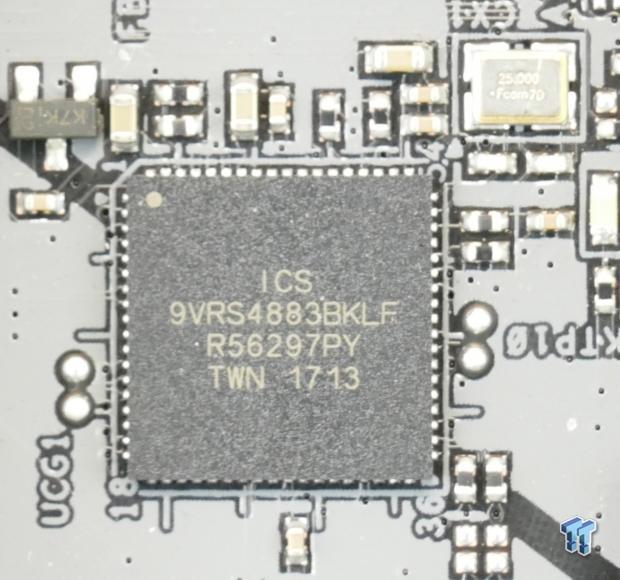
Two PI3EQX USB 3.1 re-drivers help to improve USB 3.1 signaling from the chipset's native USB 3.1 controller. The ASMedia ASM1543 is the type-C port switching controller. An ICS clock generator is used on the motherboard; the model number is 9VRS4883BKLF.
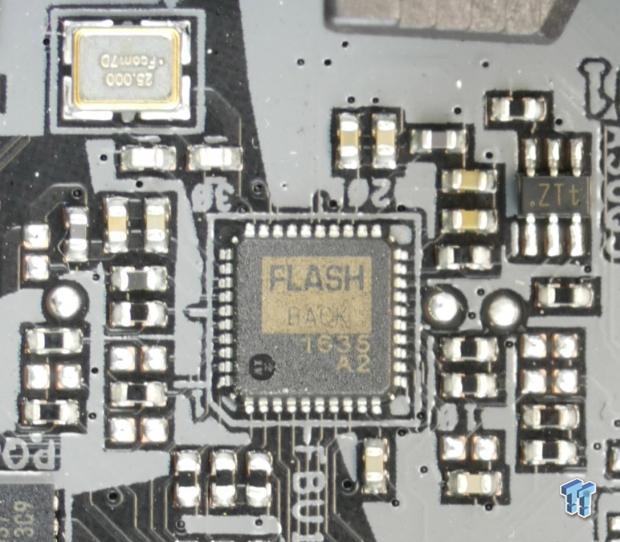
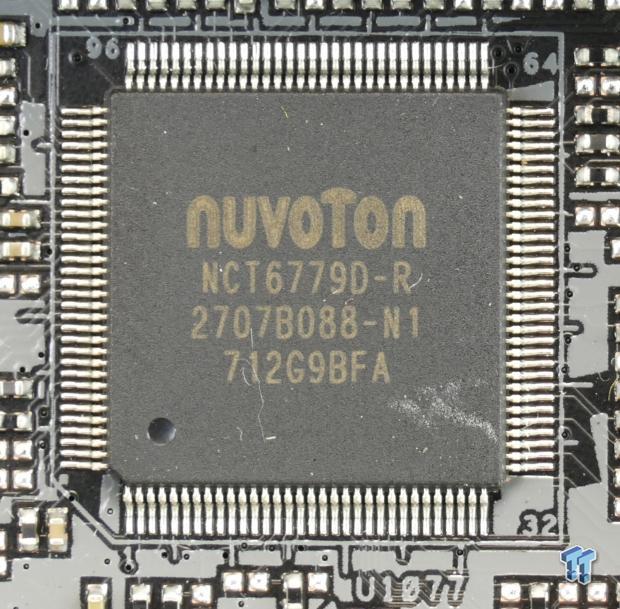
A BIOS Flashback chip is used to provide BIOS flash recovery from a USB stick. The nuvoTon NCT6779D is used as the SuperIO and provides fan control and other management features, as well as PS/2.
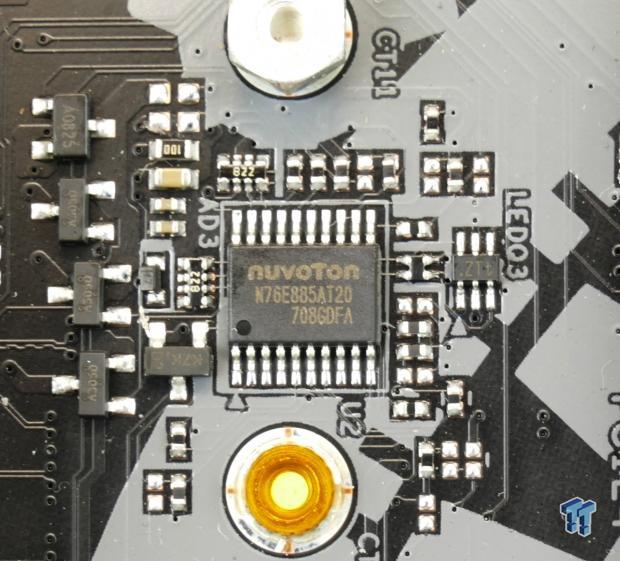
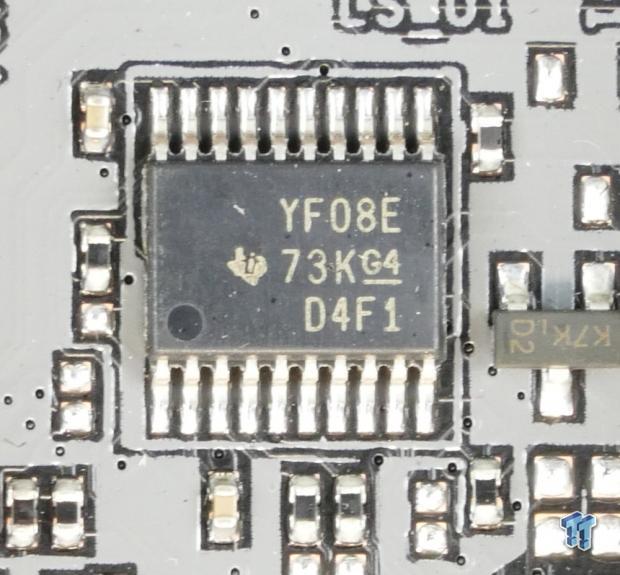
Nuvoton's N76E885AT20 provides RGB LED support through the two RGB LED headers and onboard RGB LEDs. There is also a Texas Instruments Level Shifter, used to change the voltage level of a signal, possibly helping connect some feature that works both with the CPU and chipset.
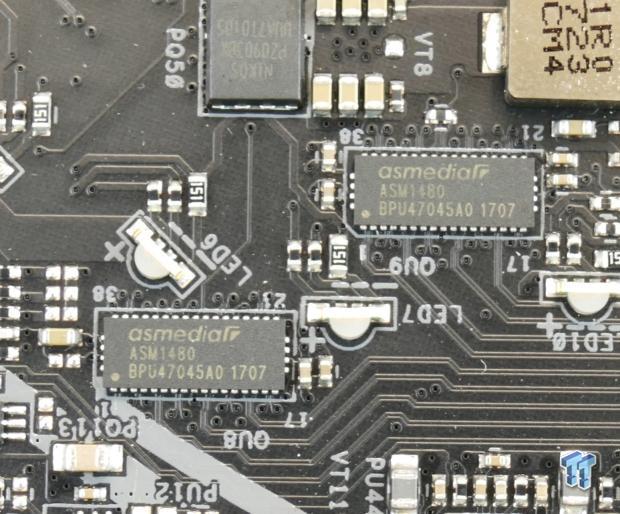
Two lone ASMedia ASM1480 are used to switch x4 PCI-E 3.0 from the CPU to either M2_1 or the U.2 port.
BIOS and Software
BIOS
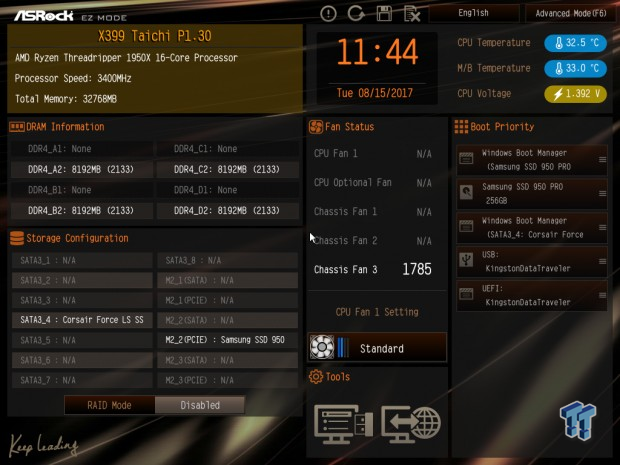
ASRock's UEFI for the X399 Taichi is very similar to that of every other Taichi motherboard. The UEFI has both an easy mode and advanced mode for users who are less or more experienced. Fan control is available through both a GUI and manual input menu.
The settings for overclocking are very easy to find and neatly organized. I only used the main input for voltage and didn't change the voltage in the menu down below the first voltage menu, and the voltage was constant, and I didn't run into any problems. There are settings for extreme overclocking as well, such as disabling MOS over temperature protection.
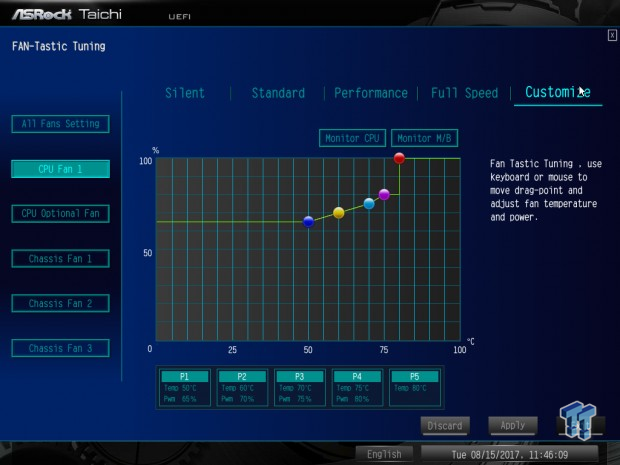
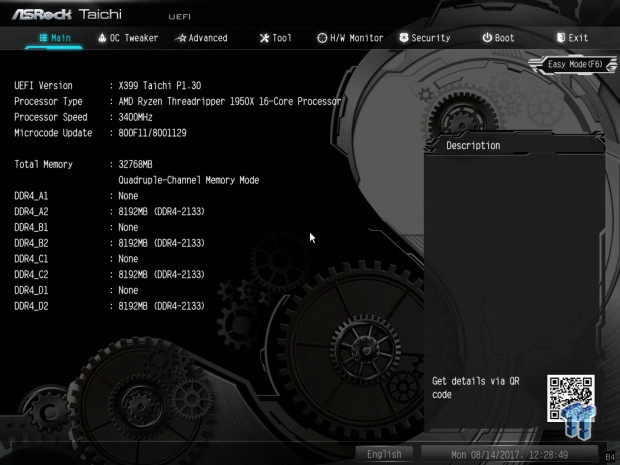
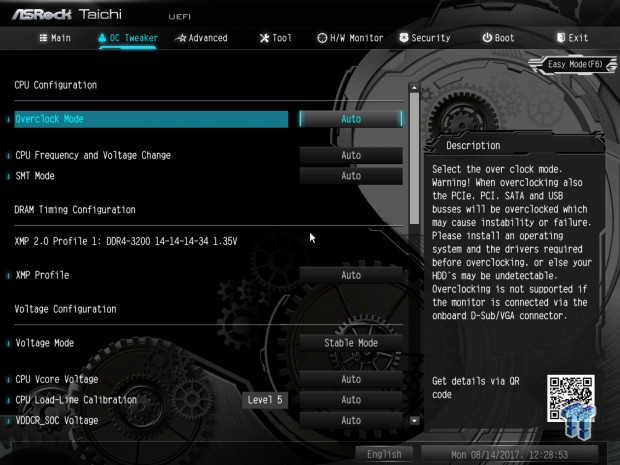
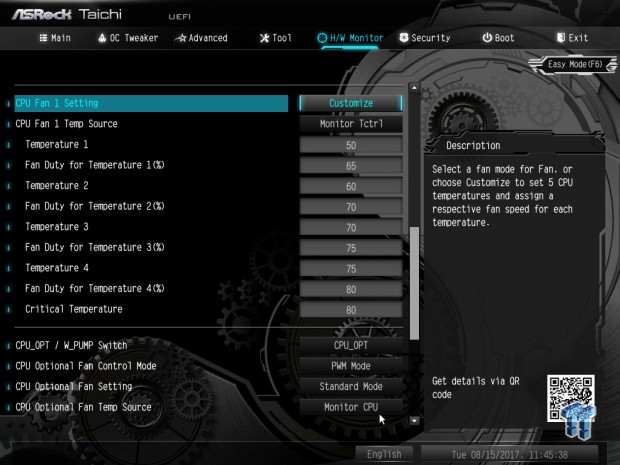
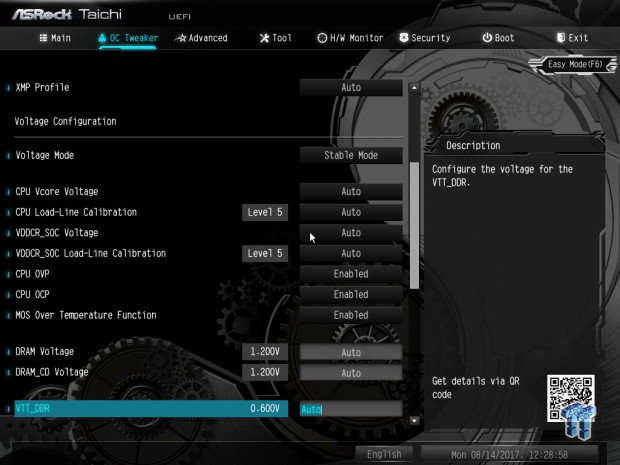
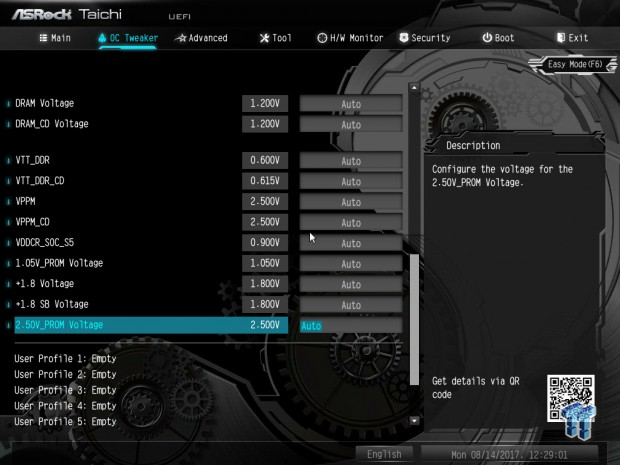
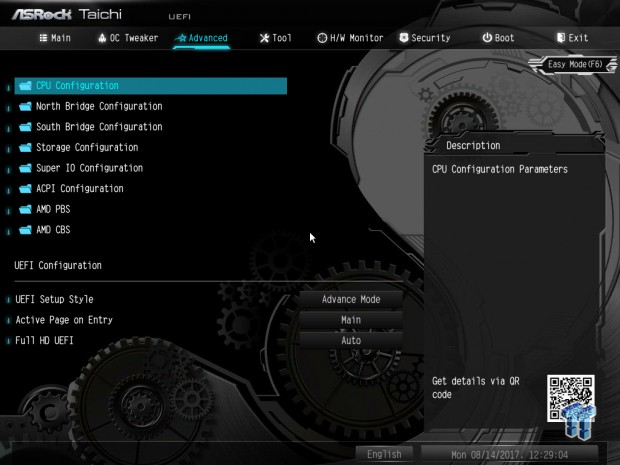
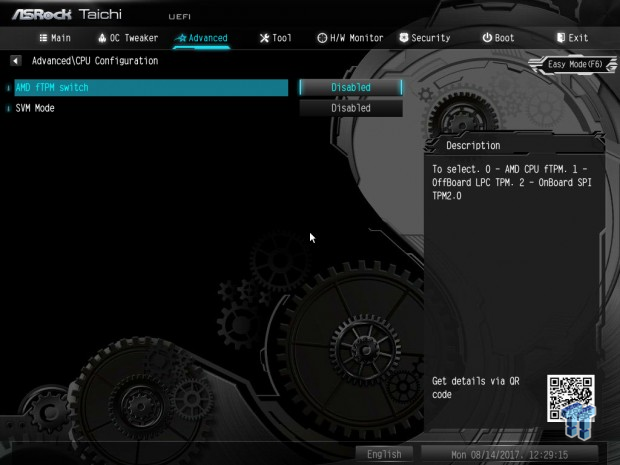
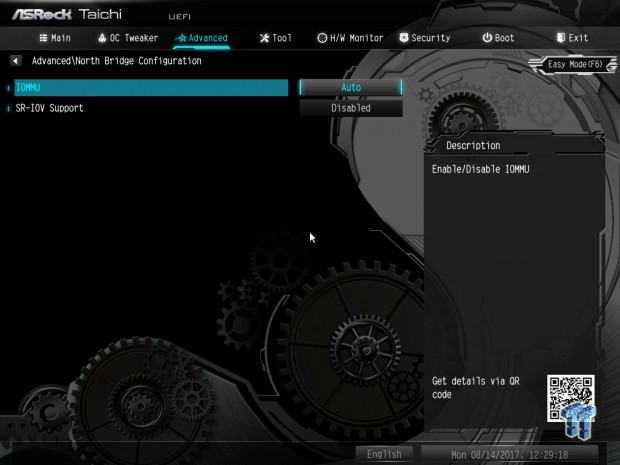
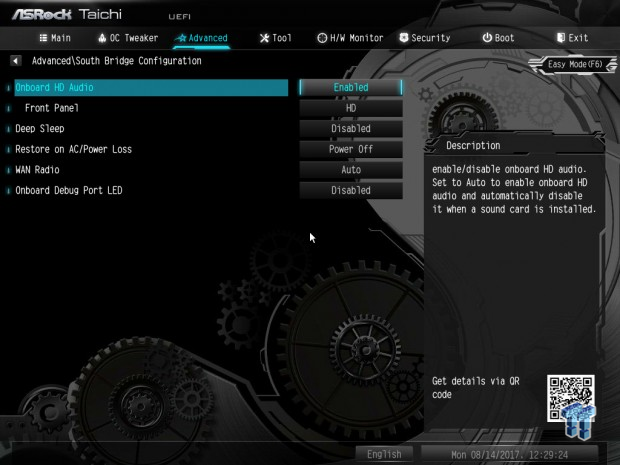
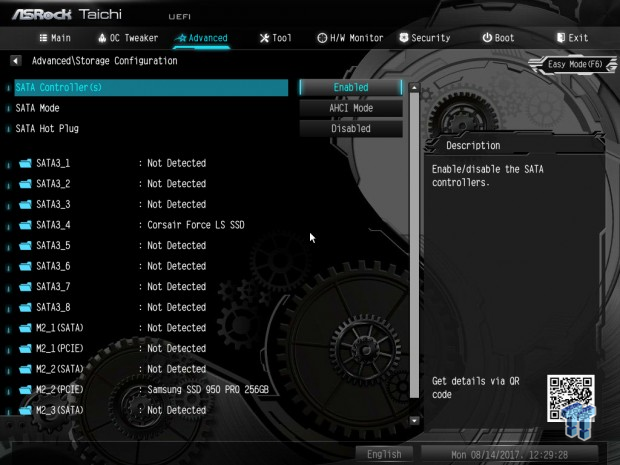
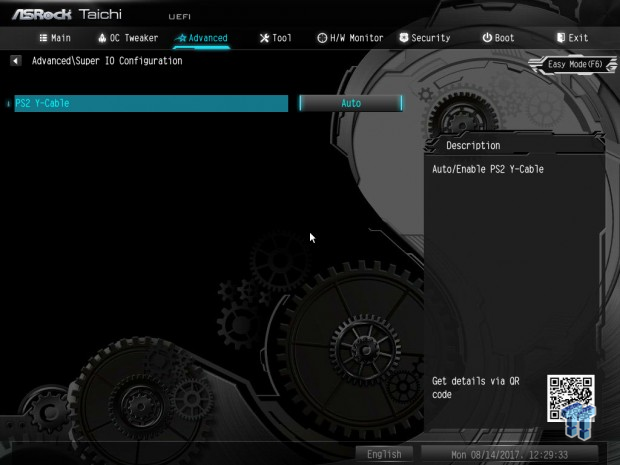
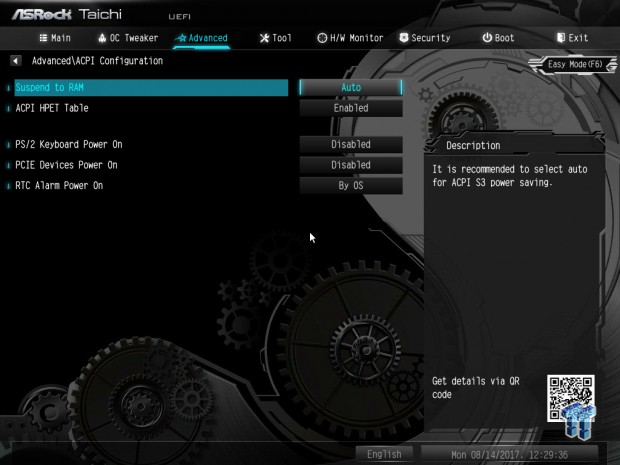
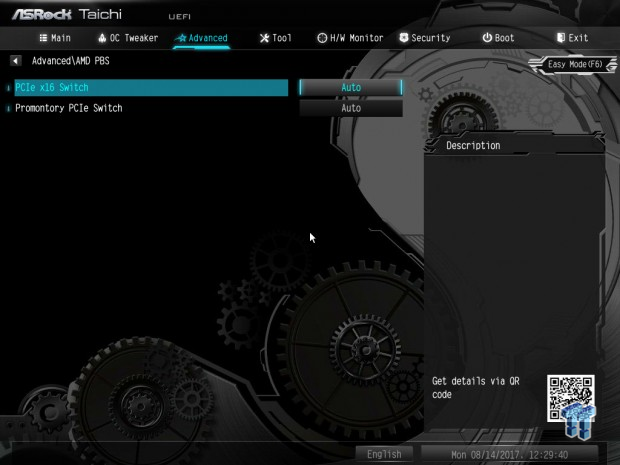
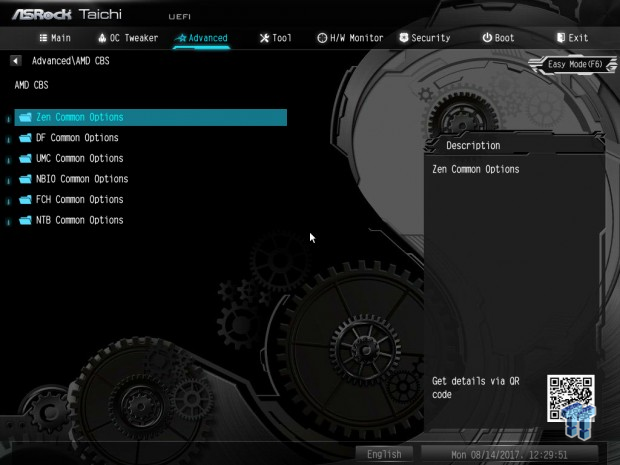
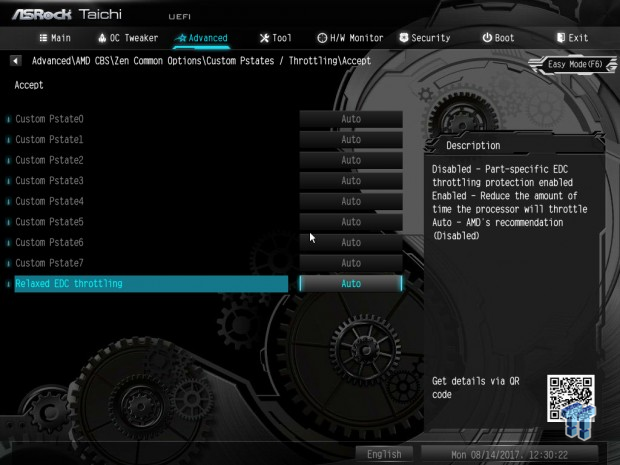
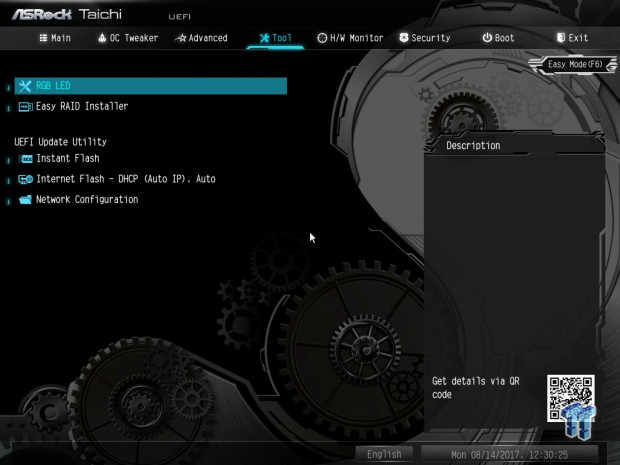
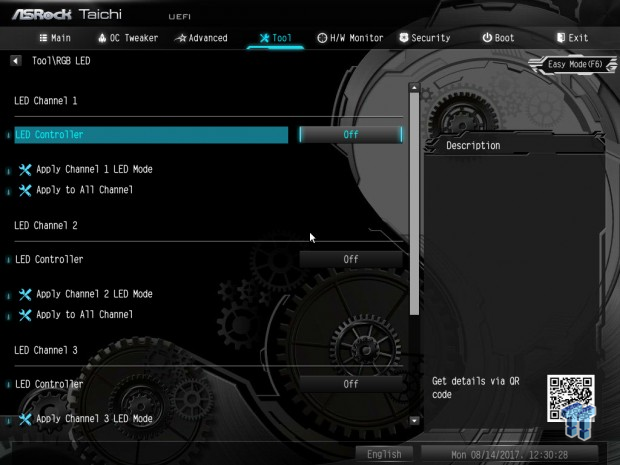
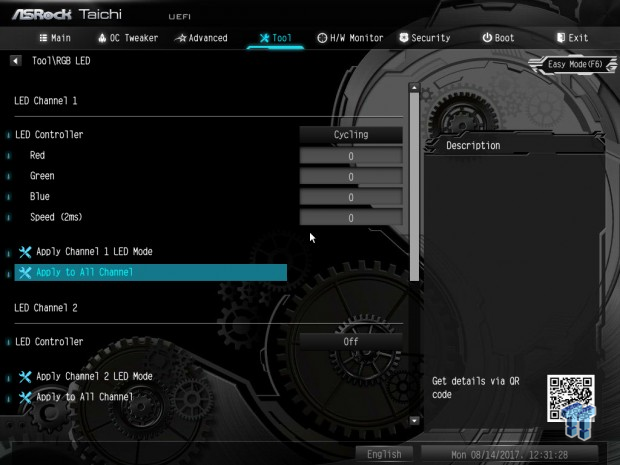
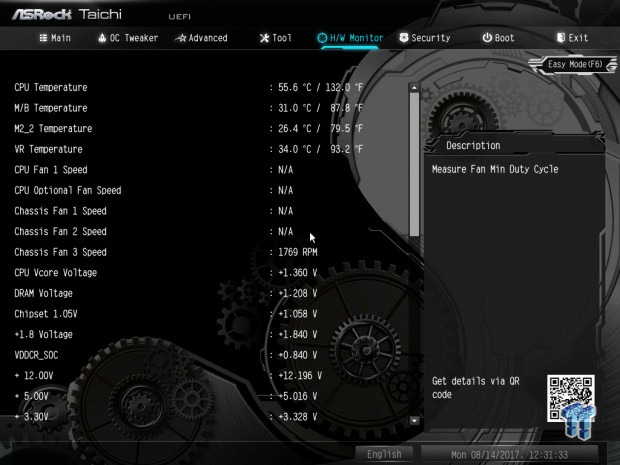
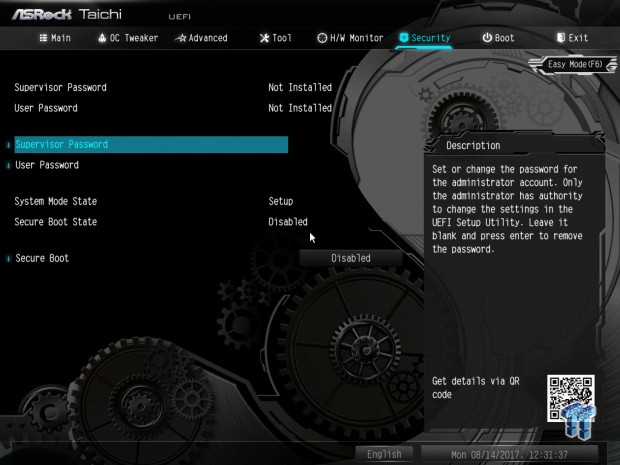
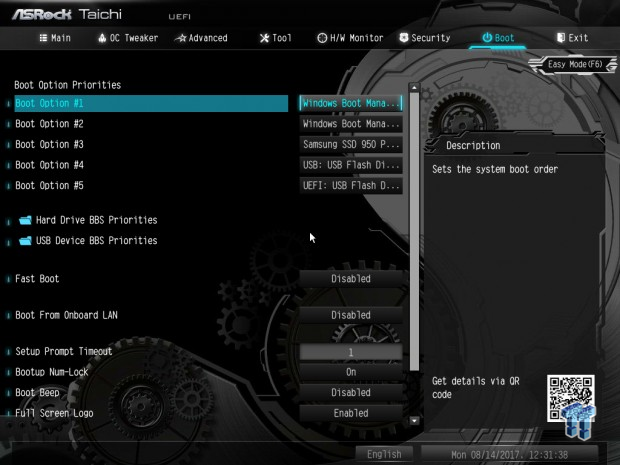
Software
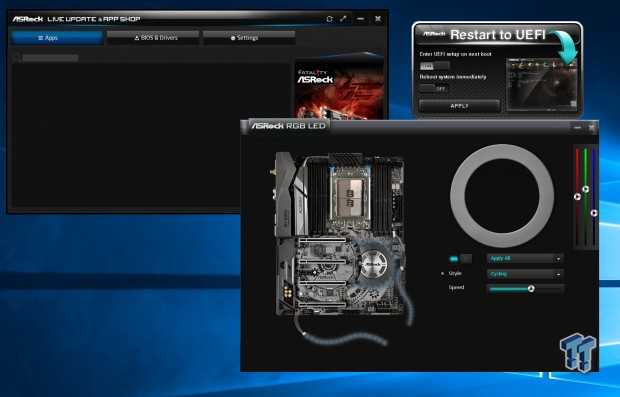
ASRock's software suite includes AURA RGB LED, APP Charger, Restart to UEFI, and APP Shop (just to name a few).
Test System Setup
Steven's Motherboard Test System Specifications
- Motherboard: ASRock X399-Taichi
- CPU: AMD Ryzen Threadripper 1950X
- Cooler: ThermalTake Riing Floe AIO - Buy from Amazon
- Memory: TridentZ 8GBx4 RGB 3200MHz
- Video Card: NVIDIA GeForce GTX 1080 Ti - Buy from Amazon / Read our review
- Storage - Boot Drive: Samsung 950 Pro 256GB
- Storage - SATA6G Drive: Corsair LS 240GB
- Storage - USB Drive: Corsair Voyager GS 64GB - Buy from Amazon / Read our review
- Case: ThermalTake Core P5 - Buy from Amazon / Read our review
- Power Supply: Corsair RM1000 - Buy from Amazon / Read our review
- OS: Microsoft Windows 10 - Buy from Amazon
- Monitor: ASUS PA328 ProArt 32" 4K - Buy from Amazon
- Keyboard: Corsair K70 LUX - Buy from Amazon
- Mouse: Corsair M65 PRO RGB - Buy from Amazon / Read our review
- Headset: Corsair VOID RGB Wireless - Buy from Amazon / Read our review
- BIOS: P1.30
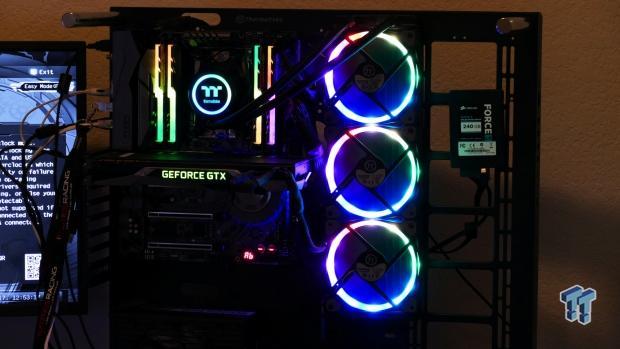
The X399 Taichi has a very low-key aesthetic on its own. In fact, it only has a single area where it has integrated RGB LEDs.
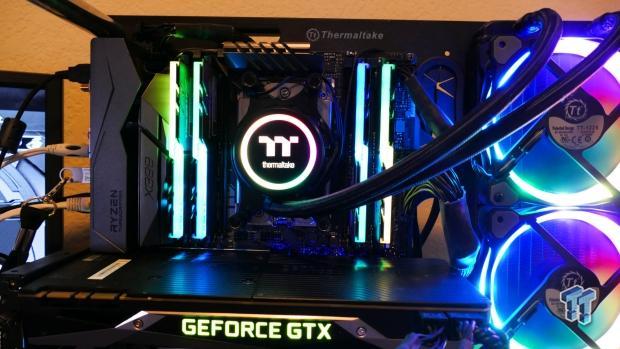
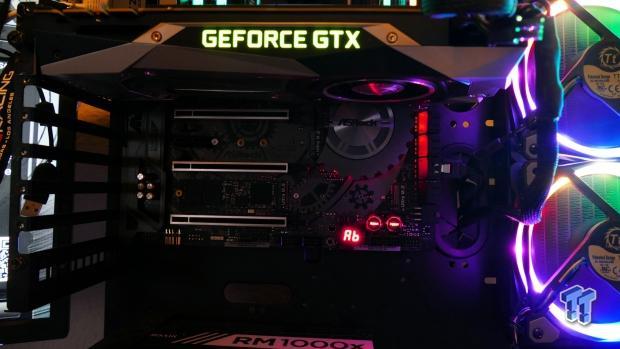
The blue glow under the PCH section can be changed to any color, and as you can see the motherboard is quite dark unless you want to light it up with RGB accessories such as DDR4 or AIO coolers.
Overclocking
Overclocking Results
CPU Overclocking
AMD's Threadripper platform is quite interesting as AMD stated the top 5% of Zen dies become Threadripper CPUs. That is a big deal, as that would also mean the CPU should overclock quite high, or at least consistently high.
My best overclock on the X370 platform was 4GHz with 3200MHz memory speeds after months of BIOS updates, so I will aim for the same here. Most people get limited around 4.1GHz, and I know my 1950X can't do 4.1GHz stable on all cores without tons of voltage or better cooling.
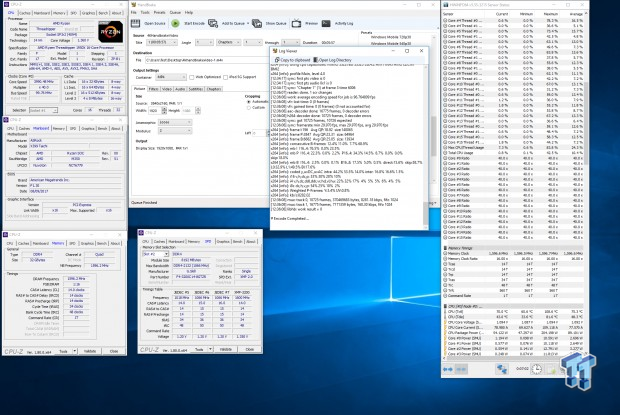
All I had to do to hit 3200MHz in quad channel was to enable XMP in the UEFI. To overclock the core, I change overclock mode to manual, and then a frequency input box and voltage input box show up.
It might be confusing as to where you input the CPU voltage, as there are actually two places, but I just used the voltage input box under the CPU frequency instead of the voltage under the voltage section of the overclocking menu. I also did not have to use LLC, but it's there in case you need to tune it.
The system was stable; the only limitation is cooling.
CPU, Memory, and System Benchmarks
CINEBENCH R15
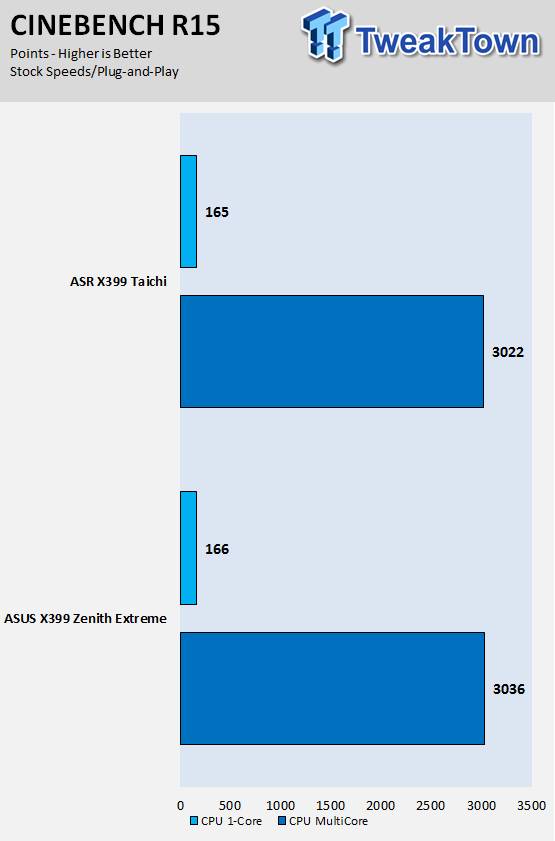
wPrime
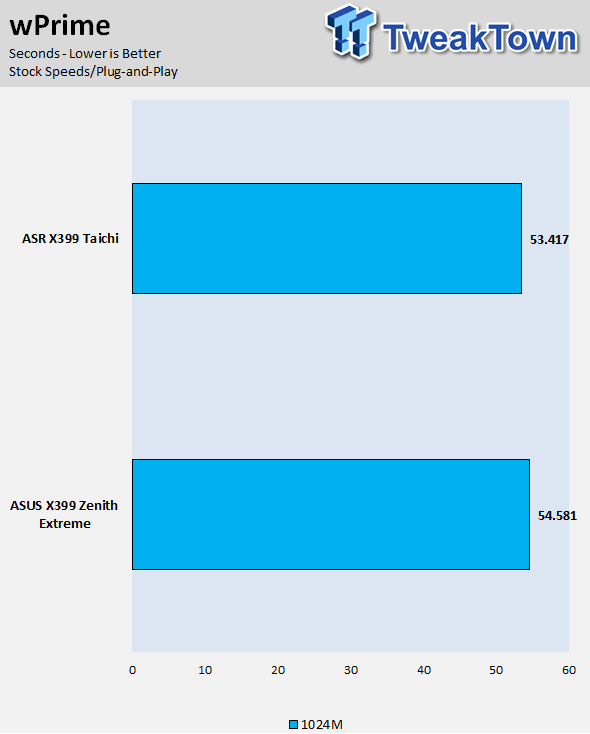
AIDA64 FPU
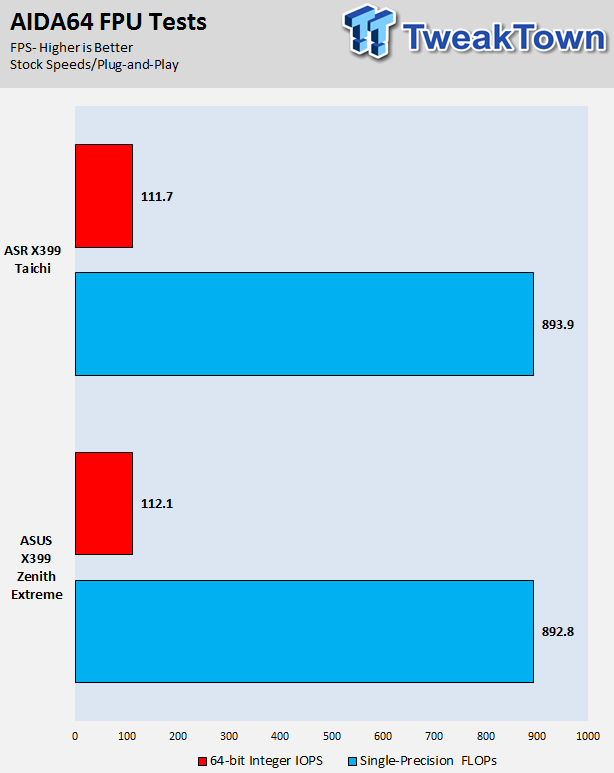
AIDA64 Memory
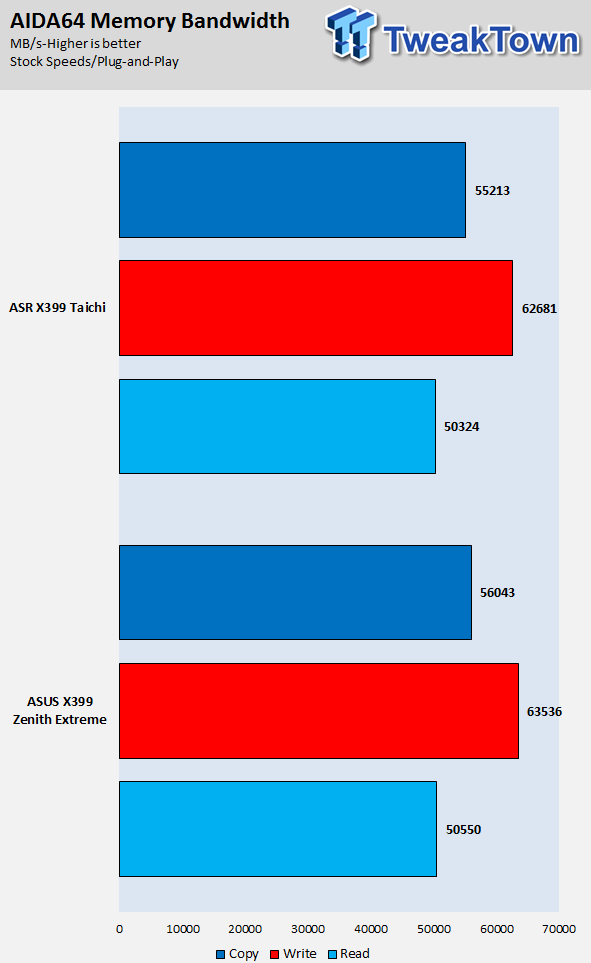
ScienceMark
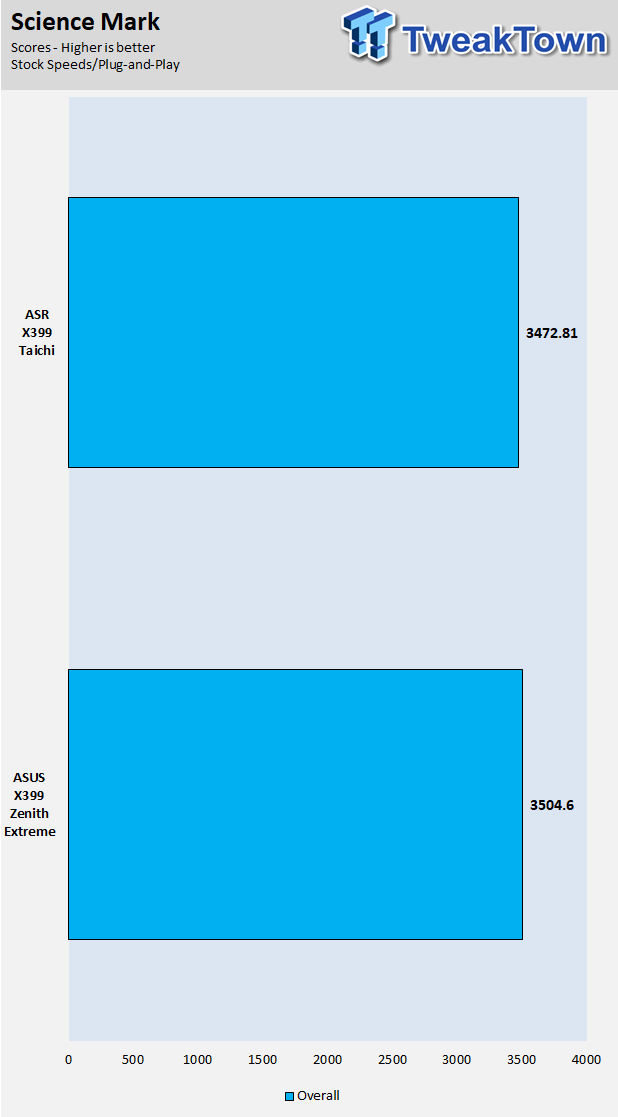
HandBrake
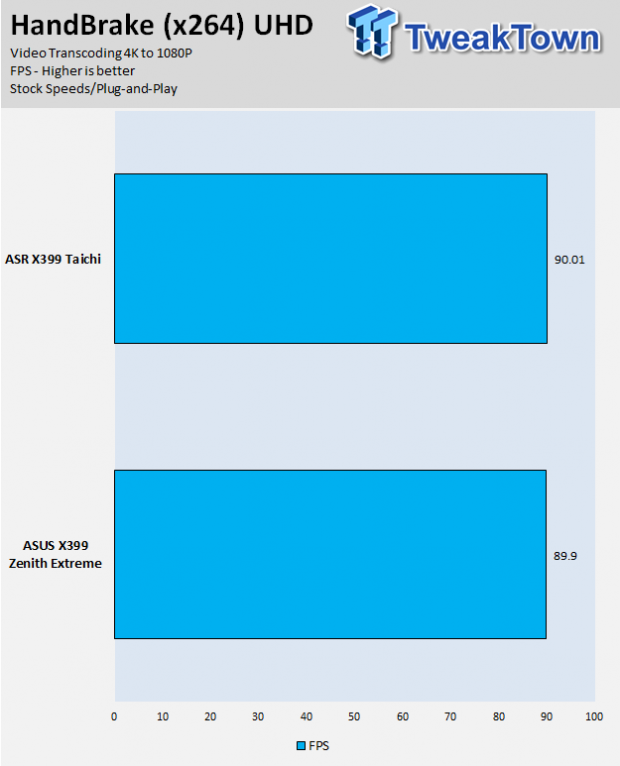
SuperPi 32M
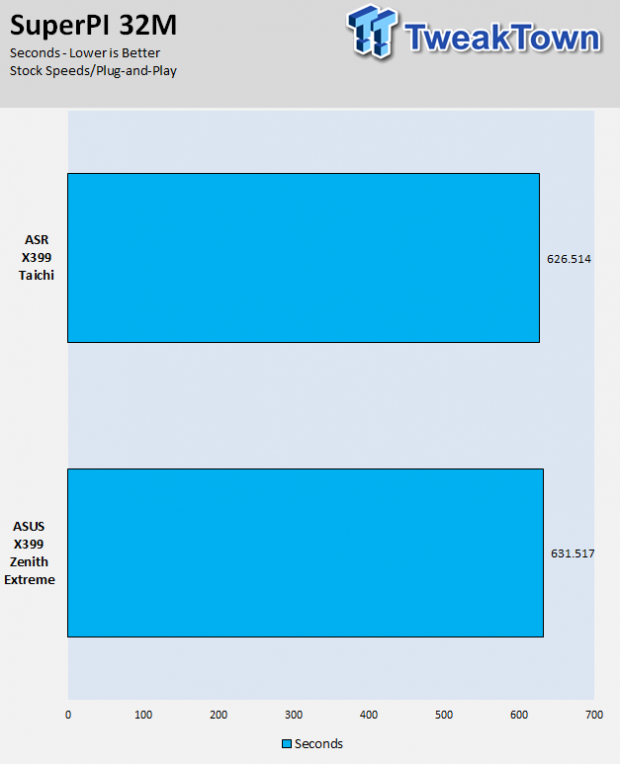
3DMark: Fire Strike
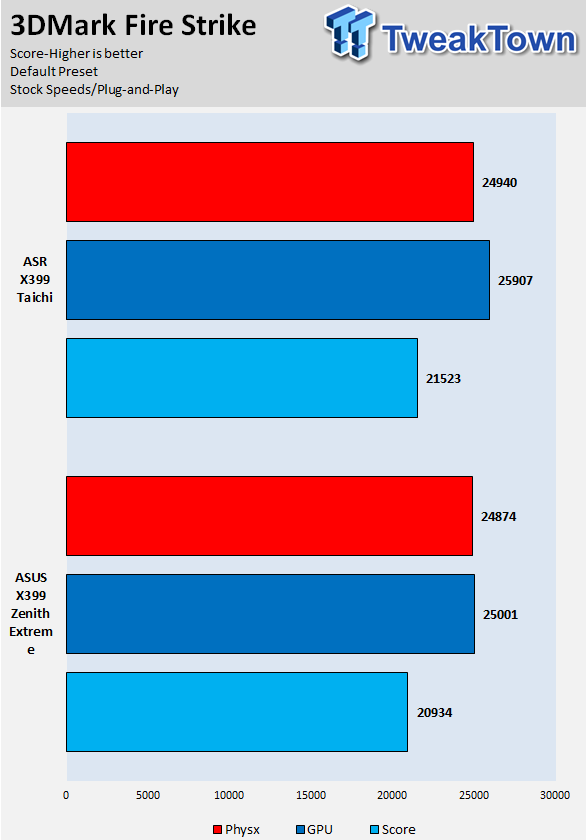
3DMark: Cloud Gate
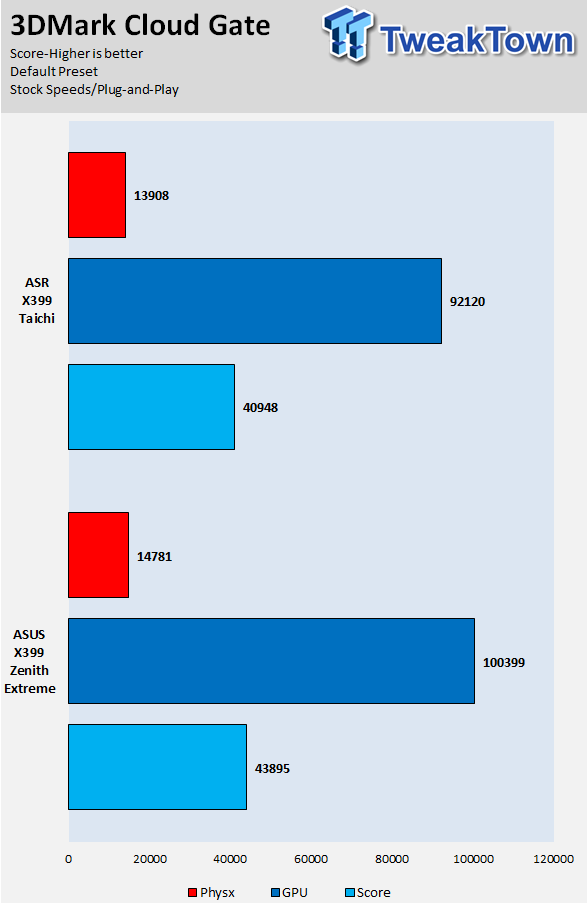
ResidentEvil 6
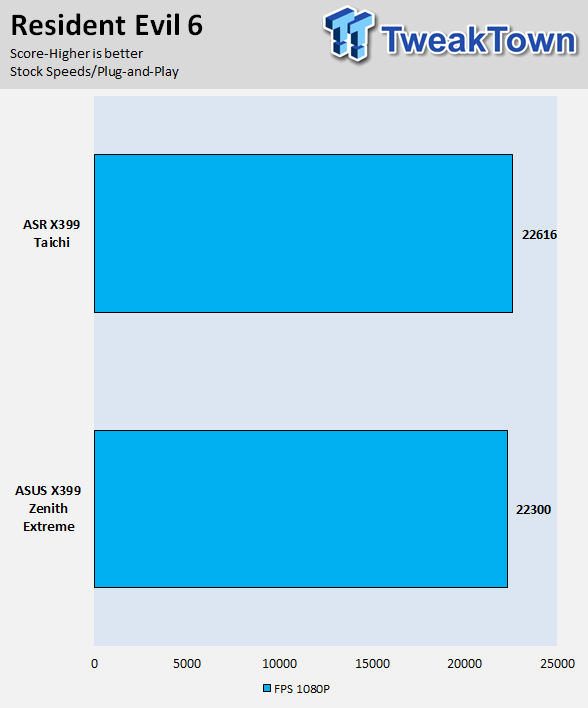
The X399 Taichi's performance is interesting, and at this point, BIOS updates with new microcodes really affect performance. For some reason, in synthetic GPU benchmarks, the motherboard doesn't do that great (a very small margin though), but it does great in real life gaming benchmarks. I expect differences like that to even out as we move towards more consistent microcode updates in AMD's AGESA code for this platform.
As of now, the motherboard's performance is solid, and there isn't anything to worry about or get excited over.
System IO Benchmarks
CrystalDiskMark SATA6G:
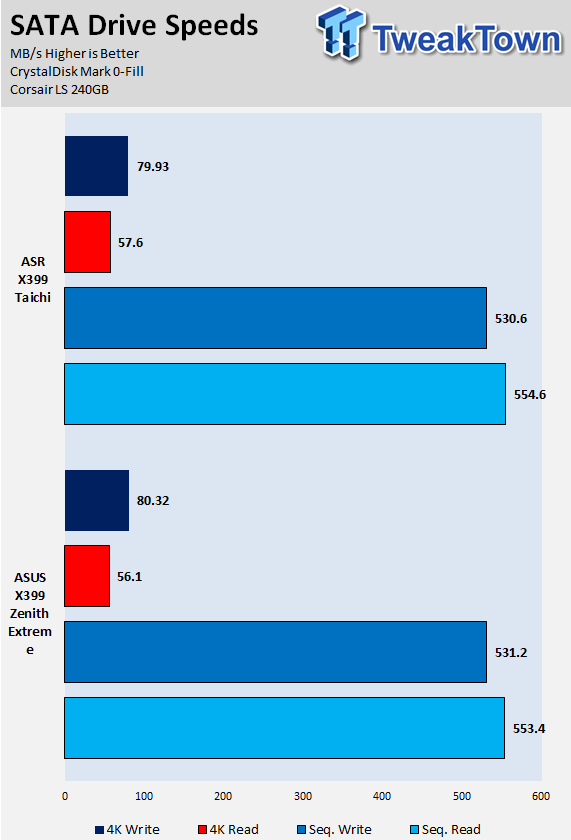
CrystalDiskMark M.2:
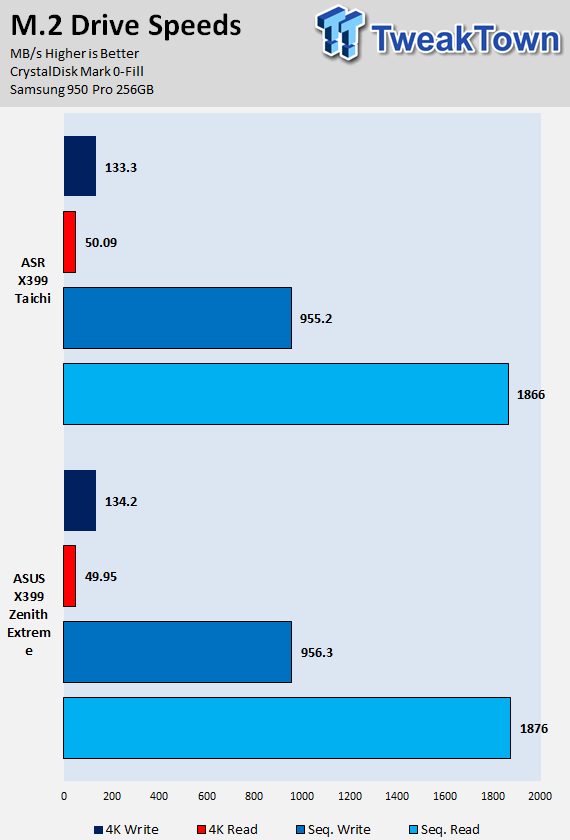
ixChariot Network Throughput:
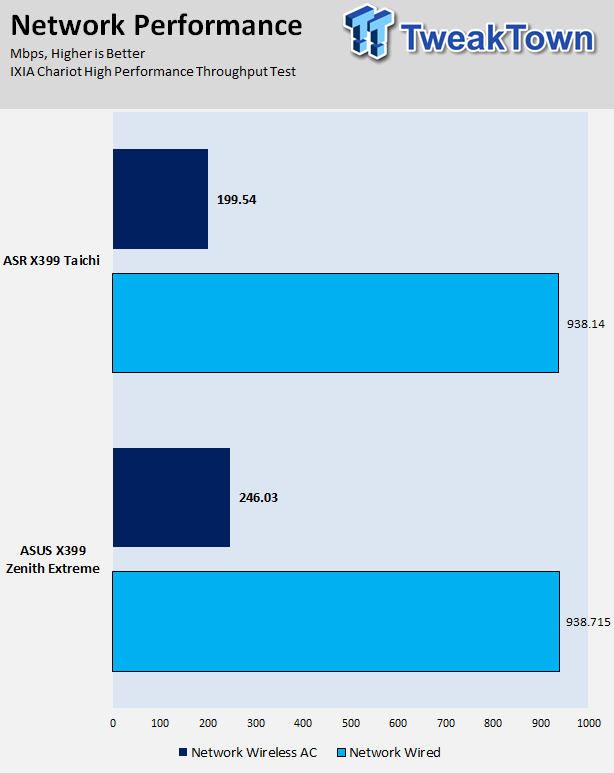
The X399 Taichi's storage is in line with what we have seen before on this platform.
However, wireless networking performance isn't that great since the controller only offers 433 Mbps wireless AC instead of 866 Mbps like most other motherboards.
Audio RMAA 5.5:
I disable all audio features, set the correct bitrates, and then test the audio with a loopback test.
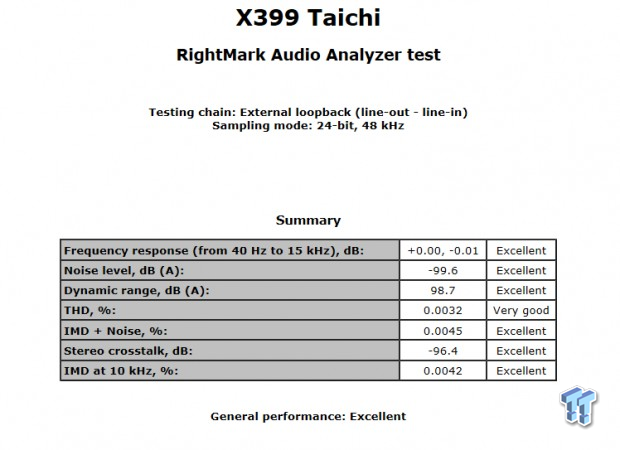
Sound Judgment by Ear: Excellent. There are five ratings for audio: 1. Problems, 2. Okay, 3. Acceptable, 4. Very good, 5. Excellent
Thermal Imaging and Power Consumption
System power is measured at the wall with an AC power meter.
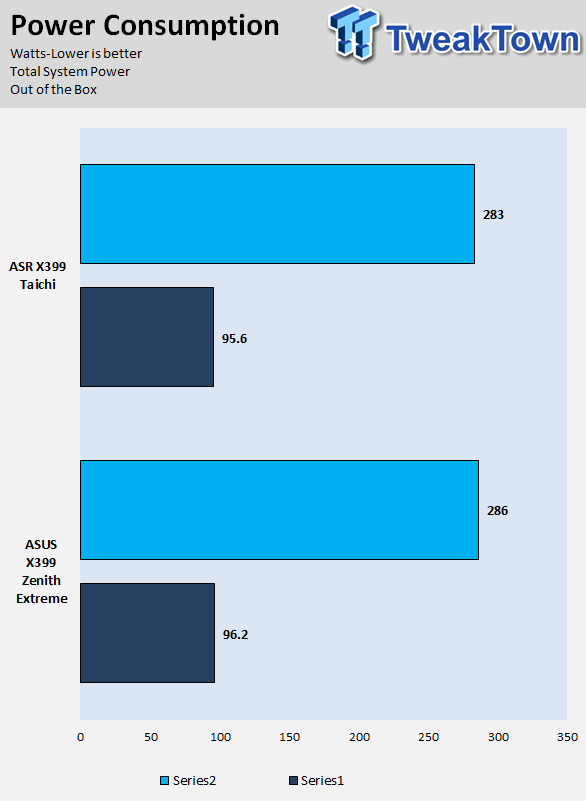
Note on Thermal Images: In the temperature section, we use our Seek thermal imaging camera to capture the surface temperatures of major components on the board. I look at the VRM and then all other things that light up the screen. If there is something to worry about, then I will state it. Otherwise, I will just show the hotter running parts of the board for fun. Unless some component is over 80-90C, then there isn't anything to worry about.
All systems will act differently, so I will look for commonalities, such as how far from the VRM the heat spreads through the PCB and the difference in temperature between the front side and backside of the PCB. Keep in mind, the majority of the heat from the VRM goes into the PCB as it is a giant soldered on copper heat sink. A larger difference in temperature between the back and front of the PCB points towards a more effective heat sink.
Thermal Testing at Stock Speeds:
The image on the left is always at idle, and the image on the right is at load. During ALL TESTS, There is no airflow direct at the VRM
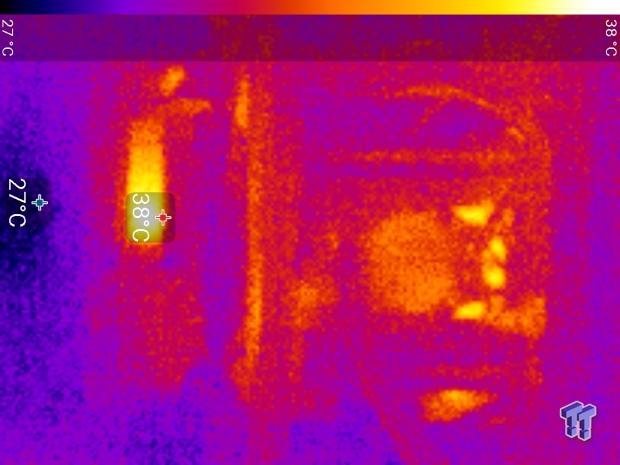
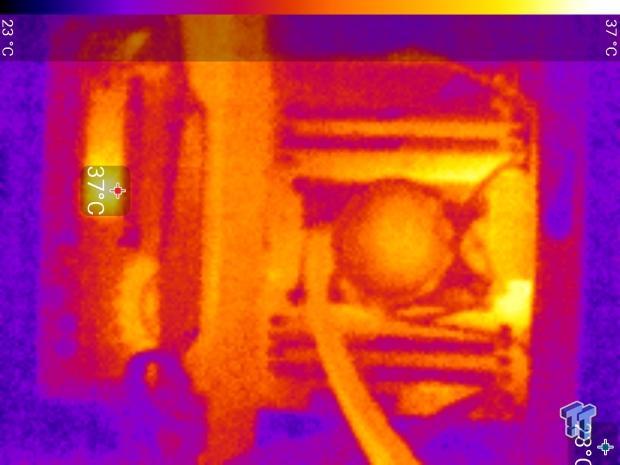
Full frontal.
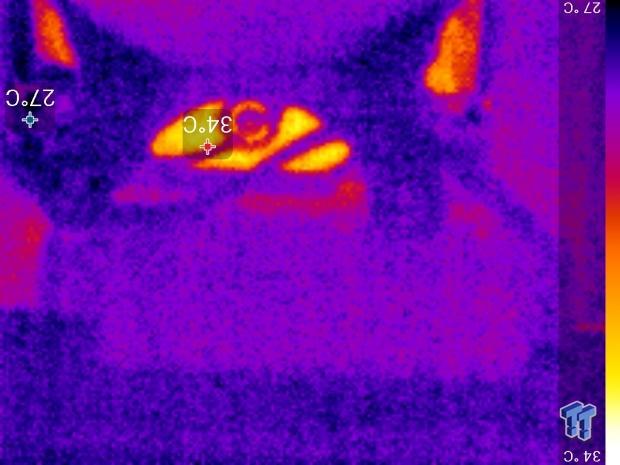
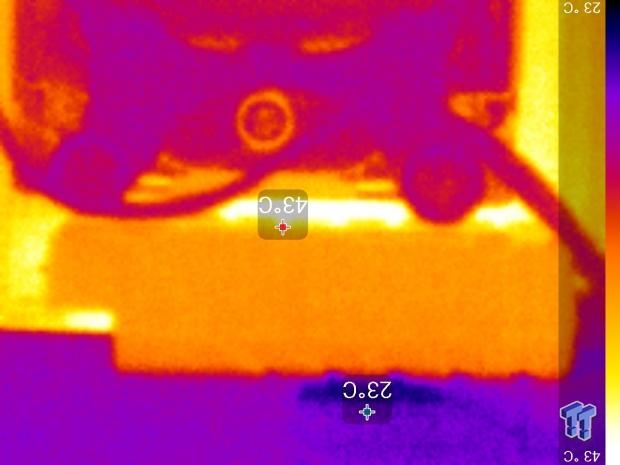
Up-close of the front of the VRM.
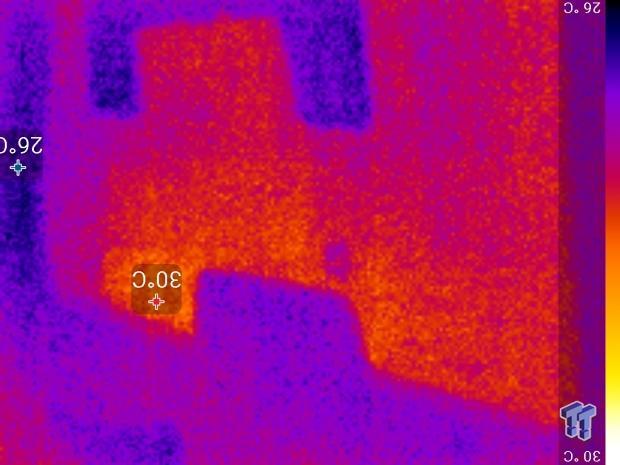
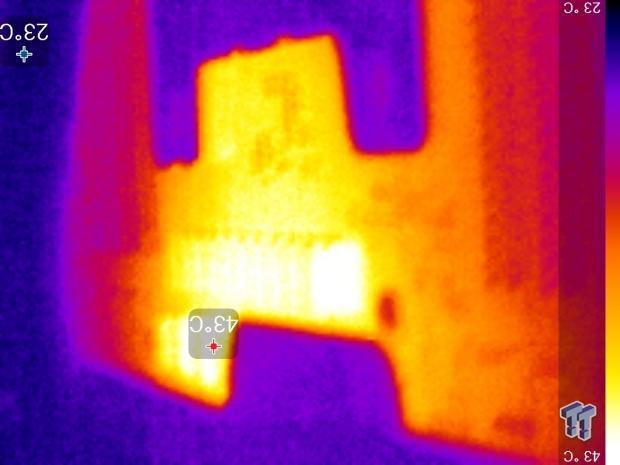
Up-close of the back of the VRM.
The X399 Taichi stock almost-worst-case thermal testing scenario reveals that the heat sink seems to be doing its job correctly. The secondary heat sink also gets warmed up, and I should mention it also cools down three phases for the SoC VRM.
Maximum temperature is 43C at load on the front and back, so heat is being moved around and dissipated. Overall, excellent thermal performance was seen.
What's Hot, What's Not & Final Thoughts
Here are key points about the ASRock X399-Taichi.
What's Hot
VRM Quality: VRM quality and cooling are a grave concern on the X399 platform, just like they are on Intel's X299 platform. ASRock's use of 60A power stages, digital PWM controller, and 60A inductors are top of the line products. The POSCAPs on the back are also plentiful (like they should be when you go from solid polymers to tantalum), so ripple should be a little bit lower. While tantalums last long, the rest of the motherboard uses 12K solid polymers. VRM cooling is also very well, and the heat sink has a lot of mass to it, so it can absorb that heat. There is also a MOS_PROCHOT switch, which I assume disable over temperature protection for extreme overclocking, so ASRock obviously has a lot of faith in its VRM design on the X399 Taichi.
OC Features: Got to have that POST code on a motherboard that costs over $300, that's something I care a lot about, and the Taichi delivers. It also offers power, reset, and clear CMOS buttons onboard. The motherboard does offer BIOS recovery through a USB stick; their BIOS Flashback feature is easy to use with a button on the IO panel. They also have some OC features in the UEFI, as well as a switch on the board to disable PROCHOT for the MOSFETs, so they can go to higher temperatures, but that is only for extreme overclocking scenarios.
Simple Aesthetics: So, while many X399 motherboards are targeted at gamers, the X399 platform isn't really a gaming platform, and I believe ASRock did a good thing by making solid looking motherboards without too many frills. The X399 Taichi has a simple and easy on the eyes look, which resembles more of a workstation board rather than one targeted at gamers. The motherboard is definitely more about business than pleasure but could play either role with ease since it has two RGB LED headers.
Relatively Affordable: I do believe that the X399 Taichi is the most cost effective X399 motherboard, meaning there isn't anything less expensive. While it's still over $300, it offers all the platform's features as well as some unique ASRock features and isn't overpriced.
What's Not
1x1 WIFI Adapter: ASRock is using the same 1x1 433Mbps wireless AC controller as they do on their X299 Taichi, and I am not sure why ASRock doesn't use a 2x2 867 Mbps controller. If you need WIFI, then the controller will get it done, but most wireless AC cards on motherboards are 2x2 867Mbps and can offer more throughput.
Final Thoughts
The ASRock X399 Taichi might be the least expensive X399 motherboard, but that doesn't mean you are missing out on quality, features, or performance. It overclocks Threadripper with ease and even has overclocking features, including a few for extreme overclocking. The VRM's component quality is top notch, and cooling for the VRM is solid.
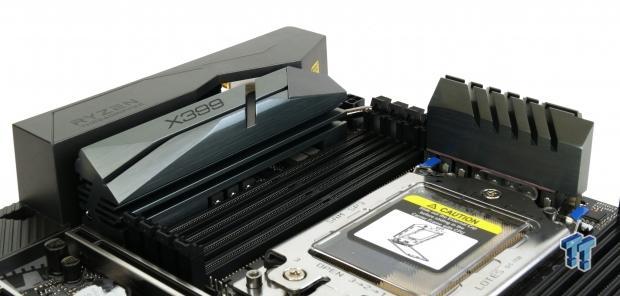
The motherboard's simple and plain aesthetics are pretty much perfect for a X399 workstation build, but you do have the ability to spice things up since the motherboard has two RGB LED headers, and you aren't getting charged for RGB LED hardware you might not use.
ASRock has done an excellent job with this X399 motherboard, and it's definitely worth a look if you need a high quality, yet affordable, X399 motherboard.

| Performance | 90% |
| Quality | 95% |
| Features | 91% |
| Value | 90% |
| Overall | 92% |
The Bottom Line: While the X399 Taichi is currently the most affordable AMD X399 Ryzen Threadripper motherboard, ASRock maintained excellent quality through and through.
PRICING: You can find products similar to this one for sale below.
 United
States: Find other tech and computer products like this
over at Amazon.com
United
States: Find other tech and computer products like this
over at Amazon.com
 United
Kingdom: Find other tech and computer products like this
over at Amazon.co.uk
United
Kingdom: Find other tech and computer products like this
over at Amazon.co.uk
 Australia:
Find other tech and computer products like this over at Amazon.com.au
Australia:
Find other tech and computer products like this over at Amazon.com.au
 Canada:
Find other tech and computer products like this over at Amazon.ca
Canada:
Find other tech and computer products like this over at Amazon.ca
 Deutschland:
Finde andere Technik- und Computerprodukte wie dieses auf Amazon.de
Deutschland:
Finde andere Technik- und Computerprodukte wie dieses auf Amazon.de
Similar Content
Related Tags
